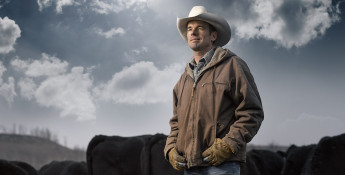By Kelsey Pagel on May 23, 2018
10 Cattle Facts that Will Impress Your Friends

1. Cows are only females.
Many of us call all cattle "cows" but in rancher talk, a cow is a cow if she has had three or more calves. There are also heifers (young female), first calf heifers (female that just had her first calf) and second-calf heifers (female that had her second calf). After that they “graduate” to cow status. Bulls are the males that do the breeding. Steers are male cattle that have been castrated (similar to neutering a dog or cat).
2. Cattle only have teeth on the bottom.
Weird, but true! They use their very long tongues to pull the grass in (like a lasso) then chew with their bottom teeth and press the grass against the hard-top palette of their mouth.
I remember when I was little, maybe four or five years old, having a bottle calf (a baby that doesn’t have a mother for one reason or another) and seeing it only had teeth on the bottom. I told my mom, “Look, this calf’s top teeth haven’t grown in yet!” She then told me they only have teeth on the bottom. I was amazed and spent a lot of time looking in their mouths until I was convinced she was right.
3. Cattle have four stomachs.
The rumen is the largest and can hold up to 50 pounds of food. Grass is ingested and stored here until the cattle burp it back up and chew their cud. The other parts of the stomach are called the reticulum, omasum and abomasum.
4. Cattle have a routine.
Cattle spend roughly eight hours a day eating, eight hours a day chewing their cud and eight hours a day sleeping. When it is hot outside, they spend their early mornings and late evenings grazing, where there isn’t shade. During the heat of the day, they lay under shade trees and chew their cud (burping back up their grass and re-chewing it. YUM!).
5. We're outnumbered in Kansas.
Cattle outnumber people in nine states including Kansas. Other states include South Dakota, Nebraska, Montana, North Dakota, Wyoming, Idaho, Iowa and Oklahoma.
6. Cows have calves about once per year.
Heifers aren’t bred for the first time until their around 14-15 months old. They'll have their calf or "calve" when they are around two years old.
7. Cattle are herd animals.
If one isn’t near the herd, chances are they are sick, giving birth or have a new baby. On that note, cattle make great babysitters. They often leave one to two cows with the baby calves all in a group and go off to eat/graze and drink before returning to them.
8. Cattle are prey animals.
By observing cattle, you can learn a lot about what’s happening around you. They can smell and hear things much sooner than a human can. If cattle are nervous, there is normally a good reason to be.
9. Cattle are vegeterians.
It is illegal to feed cows meat of any sort, so all cattle are vegetarians.
10. All beef is antibiotic free.
Ranchers take great care to follow the withdrawal labels on any medicine given. Once the animal is harvested, there are also tests done to ensure it is antibiotic free.





